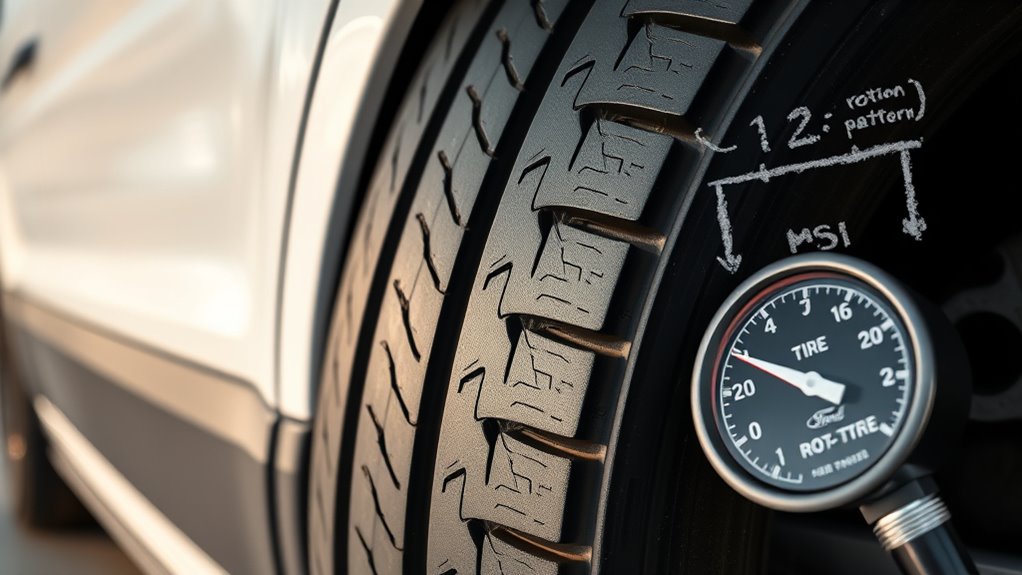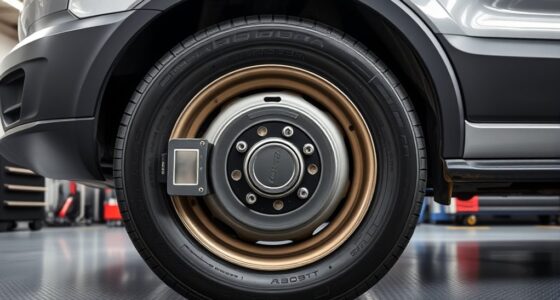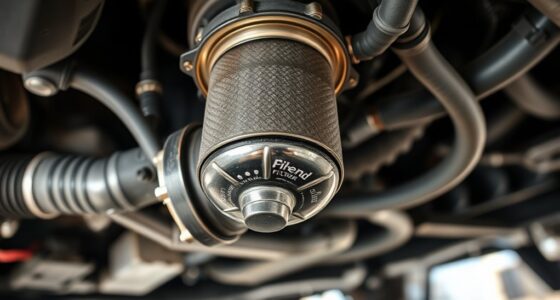To guarantee your Ford Transit performs safely and smoothly, choose the correct tire sizes like 235/65 R16C for standard models or larger sizes for off-road use. Rotate your tires every 6,000 miles using cross or same-side patterns, and keep tire pressures adjusted based on load—typically 34-38 psi for light loads and higher for full cargo. Upgrades can boost off-road capability, but maintenance and safety precautions are essential. For detailed tips and best practices, stay tuned.
Key Takeaways
- Use 235/65 R16C tires for standard Ford Transit vans, with larger sizes like 245/75R16 for ground clearance modifications.
- Follow a cross-pattern rotation for non-directional tires, and same-side rears for directional tires, every 6,000 miles.
- Adjust tire pressure based on load, typically up to 50 psi for rear tires under heavy cargo, following manufacturer guidelines.
- For dual rear wheels, rotate tires front to rear and side to side, ensuring proper tread direction and spacing.
- Check tire load ratings (119/121) and ensure proper ply rating and inflation to support vehicle weight safely.
Standard Tire Sizes for Ford Transit Models

Ford Transit models come with a range of standard tire sizes tailored to their configurations and model years. If you have a single rear wheel van, it likely uses 235/65 R16C tires, designed for durability and European standards, with a load index of 121/119. These tires have about a 28-inch diameter and a tread width of 9.3 inches. For dual rear wheel models, the common size shifts to 195/75 R16 tires, offering extra load capacity and stability for heavy-duty tasks. Some 2024 cargo vans feature 195/75 R16C on the front and 205/75 R16C on other configurations, optimized for cargo. Transit Connect Wagons may use smaller sizes like 215/55 R16 or 215/50 R17, depending on wheelbase and seating. These standard sizes balance performance and cargo needs across various models. Proper sizing ensures optimal performance and safety for your vehicle.
Understanding Load Ratings and Tire Designations

Understanding load ratings and tire designations helps you choose the right tires for your vehicle’s weight and safety needs. The load index indicates how much weight a tire can support, while ply ratings reveal its strength and durability. Knowing what these markings signify ensures you select tires that meet your vehicle’s specifications and comply with safety standards. Additionally, familiarizing yourself with tire spoilage signs can help prevent accidents caused by degraded tires. Being aware of industry standards can further guide you in selecting high-quality, reliable tires that perform well under various driving conditions. For example, understanding tire weight capacities is crucial, especially in vehicles like the Ford Transit that may require larger or heavier-duty tires to accommodate cargo loads.
Load Index Significance
The load index on a tire sidewall plays a crucial role in ensuring your vehicle can handle its maximum load safely. It’s a numeric code indicating the highest weight your tire can support at maximum inflation pressure. Using tires with the same or higher load index than your original tires is essential to maintain safe load capacity. For Ford Transit, common load indexes are 119 and 121, corresponding to capacities of about 2,998 and 3,195 pounds per tire. The load index helps match tires to your vehicle’s weight rating like the GVWR, ensuring safe operation. Proper load index selection prevents overloading, maintains safety, and supports ideal vehicle performance. Always verify the load index on the tire sidewall and consult the vehicle’s owner manual or manufacturer specifications to ensure compatibility and safety. Additionally, understanding tire designations can help you make more informed decisions about tire safety and performance. Recognizing the importance of tire ratings can further ensure your vehicle’s optimal handling and safety during various driving conditions. It is also beneficial to consider the sustainable materials used in some tires, which can impact environmental considerations and long-term durability. Being aware of tire construction types can also assist in selecting the best tires for different driving environments.
Ply Rating Explained
Ply rating is a term that originally described the actual number of fabric layers in bias-ply tires, indicating their strength and load-carrying capacity. Today, it’s a nominal measure reflecting the tire’s structural strength, not the physical layers. Modern tires use stronger materials like steel belts and synthetic fibers, so actual ply counts differ from ratings. The ply rating correlates with load capacity through Load Range letters:
- Load Range B = 4-ply
- Load Range C = 6-ply
- Load Range D = 8-ply
These ratings help determine the tire’s ability to carry weight safely, with higher ratings supporting greater loads. While not a direct count of fabric layers, ply rating remains a useful indicator of a tire’s durability and strength in current vehicle applications.
Tire Markings Meaning
Tire markings provide essential information about a tire’s load capacity and design, helping you choose the right tire for your vehicle. The load index is a number on the sidewall that indicates the maximum weight a tire can carry, measured in pounds or kilograms. For example, a load index of 91 equals 1,356 lbs. Always match or exceed your original load index rating for safety. Load range letters, like C or E, show the tire’s strength and maximum inflation pressure, with higher letters supporting higher pressures. The speed rating, marked by a letter such as H or V, specifies the maximum safe speed. Additionally, tire size codes detail width, aspect ratio, and wheel diameter, ensuring proper fit and performance. Understanding these markings helps you select tires that meet your vehicle’s needs. Proper interpretation of tire designations is crucial for ensuring safety and optimal performance, especially as AI security measures are increasingly important in automotive systems for protecting vehicle data and infrastructure.
Optimal Tire Rotation Patterns for Longevity

To maximize tire longevity on your Ford Transit, following the correct rotation pattern is essential. For non-directional tires, use the standard cross pattern: move front tires to the opposite-side rear, and rear tires straight forward on the same side. For directional tires, rotate tires front to rear on the same side, preserving the tread’s rotation direction. Always check alignment and balance during rotation to prevent uneven wear. For dual rear wheels, follow specific procedures in the owner’s manual or seek professional help. Proper tire maintenance and regular inspection are key to ensuring safety and performance. Regularly inspecting tire tread depth can help identify uneven wear early and prolong tire life. Additionally, understanding the value of home security systems can help protect your investment, including your vehicle. Here’s a quick summary:
Maximize tire life with proper rotation: cross for non-directional, front-rear for directional tires, and follow dual wheel procedures.
- Use the cross pattern for non-directional tires.
- Rotate directional tires front to rear on the same side.
- Confirm procedures for dual rear wheels, ensuring proper sequence.
- Regular rotation, every 6,000 miles, supports even wear and extends tire life.
Maintaining proper tire pressure is also crucial to prevent uneven wear and optimize performance.
Recommended Tire Pressure Settings for Different Loads

Your vehicle’s recommended tire pressure varies depending on the load you’re carrying. As loads increase, you need to adjust pressures according to manufacturer guidelines to keep your tires safe and perform well. Always check your owner’s manual or tire placard for exact settings based on your current load and driving conditions. Proper tire maintenance also helps ensure optimal performance and safety. Maintaining correct tire pressure is essential for fuel efficiency and prolonging tire life. Additionally, using appropriate load-rated tires ensures your vehicle handles increased loads safely and effectively. Being aware of potential scam warnings when purchasing tires or related services can help protect your investment and ensure compliance with safety standards.
Load-Dependent Tire Pressure
Adjusting tire pressure based on vehicle load is vital for maintaining safety and ideal performance. As your load increases, so should the tire pressure to guarantee proper contact and prevent issues. Keep in mind these key points:
- Tire pressure rises roughly 2% for every 10% increase in load, in a non-linear fashion.
- Heavier loads, like full payloads or towing, require higher pressures—up to 50 psi or more for rear tires.
- Rear tires typically need more pressure adjustment than front tires, especially under heavy loads. Understanding AI detectors can help ensure your vehicle’s safety systems operate correctly.
- Regularly assess and adjust tire pressures to ensure optimal safety and tire longevity. Monitoring rear tire pressure is fundamental for stability and tire longevity. Use a reliable gauge and adjust pressures accordingly, balancing safety, traction, and tire wear for ideal performance.
Manufacturer’s Recommended Settings
| Load Type | Recommended Cold Tire Pressure |
|---|---|
| Light Load | 41-44 psi |
| Heavy Load | 50-55 psi |
| Rear Axle (Heavy) | 64 psi |
| Front Axle (Light) | 57 psi |
| Max Sidewall | 51 psi |
| Proper tire pressure ensures optimal sound design and vehicle safety during operation.
Adjustments for Road Conditions
When driving on different road conditions, it’s important to modify your tire pressure to match the terrain and load. Proper adjustments help prevent damage, improve traction, and ensure safety. Consider these guidelines:
- On rough or unpaved roads, increase pressure slightly to resist damage and reduce pinch flats.
- For softer surfaces like sand or snow, lower pressure to enhance traction and minimize sinking.
- During high-speed highway driving, maintain or slightly raise pressure within the manufacturer’s limits to prevent heat buildup.
Adjustments should respect your tires’ sidewall strength and safety limits. For light loads, pressures around 34–38 psi are typical, but fully loaded vehicles may need 50 psi or more. Regularly monitor tire pressure for ideal performance and safety.
Impact of Tire Upgrades on Performance and Off-Road Capability
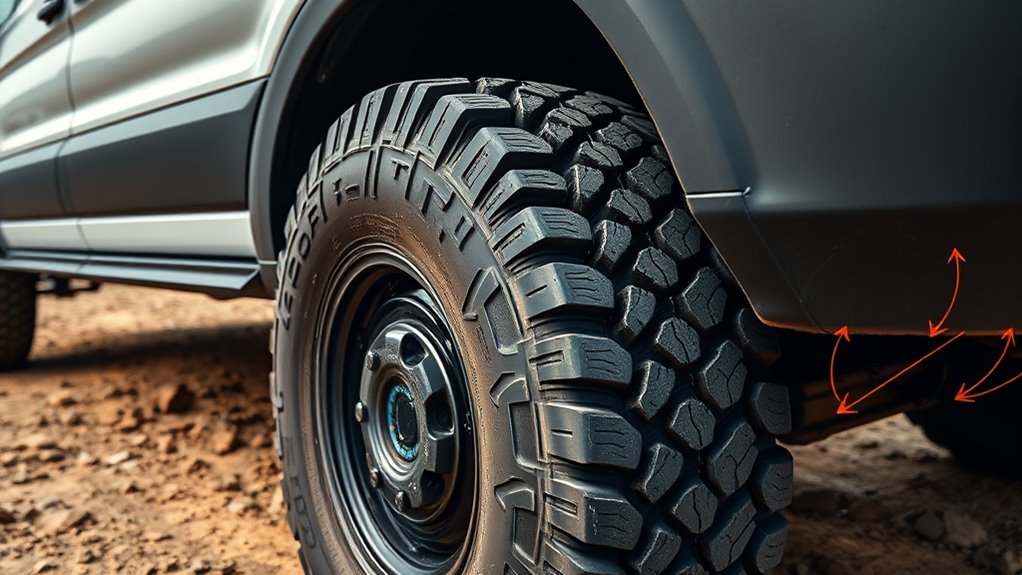
Upgrading your tires can considerably boost your vehicle’s off-road performance and handling. Larger tires increase ground clearance by about 1.25 inches, helping you clear obstacles more easily and reducing the risk of underbody damage. Off-road-ready all-terrain tires, like BFGoodrich KO2, deliver better mud and snow traction without needing body modifications. They also improve approach and departure angles, making steep inclines and declines less challenging. Enhanced grip on diverse surfaces comes from lower tire pressures, which increase the contact patch for better traction and stability. Keep in mind, larger tires affect your speedometer reading and fuel efficiency. They also add rotational mass, which can influence handling. Proper maintenance, including rotations and pressure checks, ensures you maximize the benefits of your upgraded tires for off-road adventures.
Signs of Wear and When to Replace Your Transit Tires
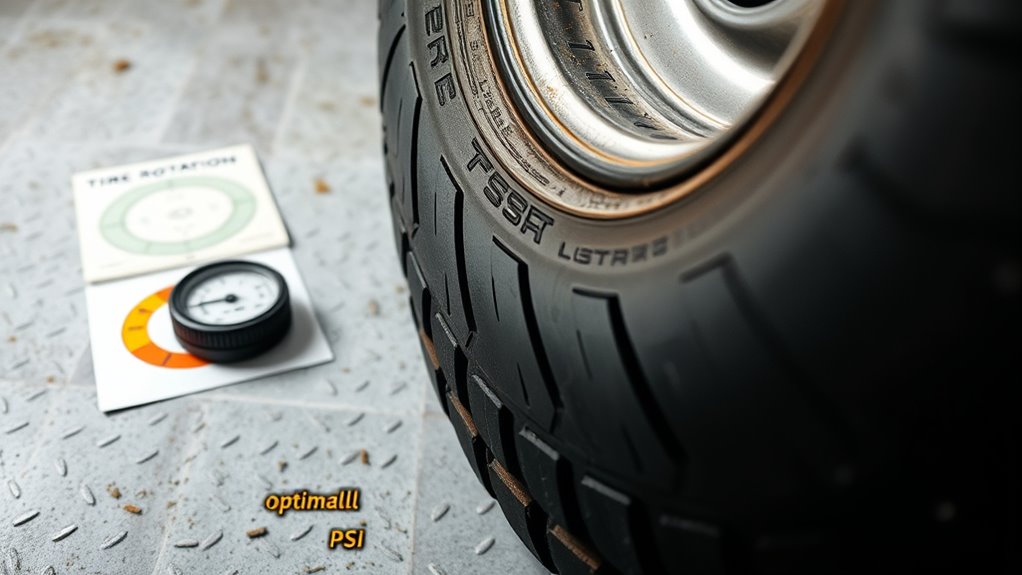
You should regularly check your transit tires for signs of wear that could compromise safety. Look for low tread depth using indicators or a gauge, visible sidewall damage, or uneven wear patterns across the tread. Addressing these issues early helps prevent tire failure and keeps your vehicle running smoothly.
Tread Depth Indicators
Tread depth indicators are essential tools for determining when your Ford Transit tires need replacing. They help you gauge whether your tires provide adequate traction and safety. When the wear indicators or safety bands become visible at about 1.6 mm, it’s time to replace your tires immediately. Here are key points to consider:
- Tire wear bars signal when tread depth reaches the legal minimum of 1.6 mm, indicating the need for replacement.
- Penny test: If Lincoln’s head is visible in the grooves, your tread depth is below 2/32 inch, and replacement is urgent.
- Visual cues: Uneven or worn tread patterns suggest the need for inspection and possible replacement before safety is compromised.
Regular checks ensure safe driving conditions and compliance with safety laws.
Visible Sidewall Damage
Visible sidewall damage on Ford Transit tires can indicate serious internal issues or external impacts that compromise safety. Bulges or bubbles suggest internal cord damage, often caused by hitting potholes or sharp objects. Cuts from road debris or protruding parts weaken the tire’s structure, increasing the risk of failure. Abrasions and scrapes happen when tires rub against curbs or rough surfaces, while cracks develop over time from UV exposure, drying out the rubber. Missing chunks or gouges may result from severe impacts or prolonged abrasive contact. If you notice pronounced bulges, deep cracks, cuts, or missing rubber, it’s time to replace the tire. Regular inspections and prompt replacement help prevent blowouts and ensure your vehicle’s safety on the road.
Uneven Wear Patterns
Uneven wear patterns on Ford Transit tires can signal underlying problems that compromise safety and performance. Recognizing these signs helps prevent further damage and guarantees safe driving. Here are key indicators:
- Increased vibrations or pulling to one side, signaling imbalance or alignment issues.
- Noticeable tread depth differences between inner and outer edges or front and rear tires.
- Unusual noises during cornering, suggesting irregular tread contact.
Other signs include feathering and diagonal wear, which point to improper toe settings or suspension problems. Regular visual inspections and measuring tread depths help catch early wear issues. If you observe these patterns, it’s time to check your alignment, suspension, and tire pressure. Addressing uneven wear promptly maintains ideal handling, extends tire life, and keeps your Transit safe on the road.
Seasonal Tire Changes and Winter Tire Considerations
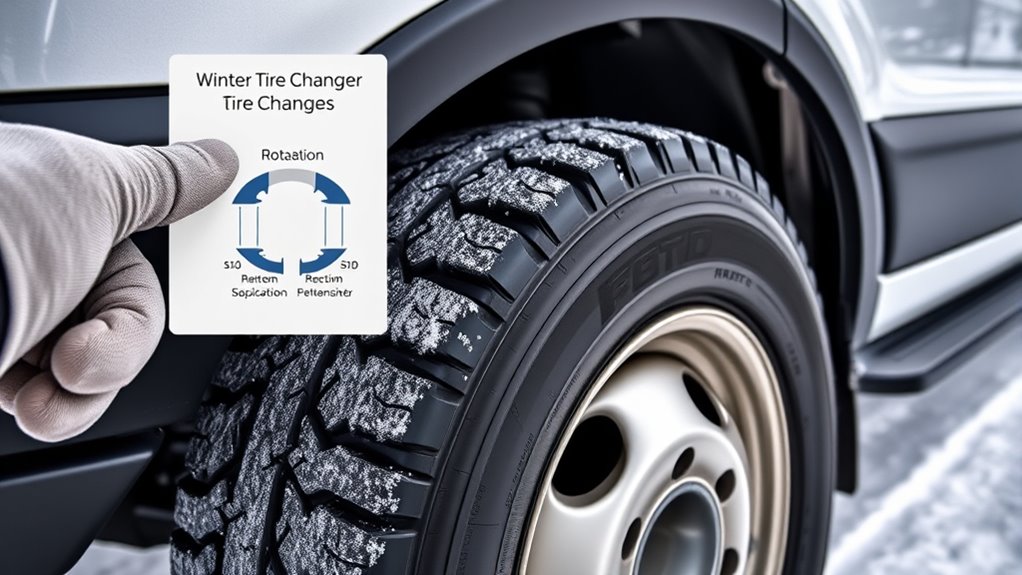
Switching to winter tires at the right time is essential for maintaining safety and ideal performance during colder months. You should install winter tires when temperatures consistently drop below 7°C (45°F), as this helps the rubber maintain flexibility and grip. Changing tires too early or too late can reduce their effectiveness and compromise safety. Typically, you’ll swap tires in late fall and remove them in early spring, based on regional climate patterns. Using dedicated steel wheels simplifies this process. Regularly monitor weather forecasts and road conditions to determine the best timing. Remember to check tire pressures when changing tires, as cold weather reduces air pressure. Proper seasonal tire changes ensure maximum traction, safety, and vehicle handling throughout winter.
How to Choose the Right All-Terrain Tires

Choosing the right all-terrain tires for your Ford Transit involves evaluating compatibility, performance, and vehicle modifications. First, consider tire size: options like 245/75R16 or 255/70R16 improve ground clearance but may require a suspension lift and fender trimming. Second, check the load index to ensure the tires can support your vehicle’s weight safely, especially for AWD or heavy cargo models. Third, look for certifications like the 3PMSF symbol, confirming winter readiness and regional compliance. Pay attention to tire types with strong off-road traction, durability, and snow/mud performance, such as BFGoodrich KO2 or Falken Wildpeak A/T3W. Proper selection guarantees enhanced capability without compromising safety or requiring excessive modifications.
Tips for Maintaining Proper Tire Balance and Alignment

Maintaining proper tire balance and alignment is essential for safe and smooth driving, especially on your Ford Transit. Proper balance minimizes vibrations at high speeds, improving comfort and preventing uneven tread wear that can shorten tire life by up to 25%. Ensure wheel weights are accurately applied during mounting and have your tires balanced every 5,000 to 7,000 miles or when vibrations occur. Regularly check and maintain proper alignment to prevent uneven tire wear, which can cause premature replacements and affect handling. Rotate your tires every 6,000 to 7,000 miles, inspect wheel rings annually, and always check lug nut tightness after service. Monitoring tire pressure monthly also helps maintain ideal balance and alignment, keeping your Transit running smoothly and efficiently.
Safety Precautions When Installing New Tires

Installing new tires safely requires careful preparation and adherence to proper procedures to prevent accidents and damage. First, verify your work area is well-lit, clean, and free of hazards. Confirm the vehicle is stationary with the engine off, parking brake engaged, and wheel chocks in place. When handling tires, follow these steps:
Ensure your work area is clean, well-lit, and the vehicle is safely secured before installing new tires.
- Use personal protective equipment like gloves, safety glasses, and safety shoes to protect yourself.
- Position jacks securely, following manufacturer guidelines, and use proper tools to prevent rim movement.
- During inflation, stand at least 10 feet away from the tire, aligned with the tread, and avoid flammable substances or ignition attempts.
Following these precautions minimizes risks, ensuring a safe and effective tire installation.
Frequently Asked Questions
How Do I Determine the Correct Tire Size for My Specific Ford Transit Model?
To find the correct tire size for your Ford Transit, check the driver’s side door jamb sticker for the original size. You can also look at the sidewall of your current tires. For added certainty, consult your vehicle’s manual, visit a professional tire dealer, or explore Ford’s official specs online. Matching the exact size guarantees safety, proper handling, and compliance with manufacturer standards.
Can I Use Non-Standard or Aftermarket Tires on My Ford Transit Safely?
Using non-standard or aftermarket tires on your Ford Transit is like trying to fit puzzle pieces from different sets; it can work but risks misalignment and safety issues. You can do it if you choose tires with the correct load rating and size, but you must guarantee they’re legally compliant and won’t cause handling problems. Always consult a professional to confirm compatibility, safety, and any needed vehicle modifications.
What Are the Consequences of Under- or Over-Inflating My Transit Tires?
If you under-inflate your Transit tires, you risk blowouts, reduced stability, longer braking distances, and faster tire wear on edges. Over-inflation causes decreased traction, a harsher ride, uneven tread wear, and unstable steering at high speeds. Both conditions increase safety hazards, lower fuel efficiency, and shorten tire lifespan. To stay safe and save money, always maintain the tire pressure recommended by Ford for your Transit.
How Often Should I Check My Tire Pressure for Optimal Safety?
You should check your tire pressure at least once a month to keep your Ford Transit safe and efficient. Did you know that underinflated tires can increase fuel consumption by up to 3%? To stay ahead, check your tires when they’re cool, especially before long trips. Regular monitoring helps prevent blowouts, extends tire life, and guarantees peak handling—making every drive safer and more economical.
Are There Any Modifications Needed to Install Larger Tires on My Transit?
You’ll need to make some modifications to install larger tires on your Transit. Typically, you should trim about 1.5 inches of the front pinch weld and cut roughly 1 inch off the front air dam to prevent rubbing. You might also need to modify or trim fender liners and wheel well liners. For bigger tires, consider adding a lift kit for enough clearance and safe handling.
Conclusion
By following these tire size, rotation, and pressure tips, you’ll keep your Ford Transit rolling smoothly and safely for miles to come. Proper maintenance isn’t just routine—it’s your secret weapon against unexpected breakdowns and costly repairs. Think of your tires as the heartbeat of your vehicle; neglect them, and everything else grinds to a halt. Stay vigilant, prioritize safety, and enjoy the unstoppable performance of your Transit on every adventure!
